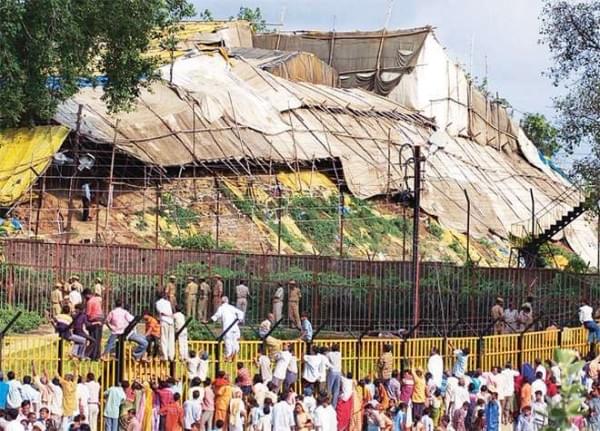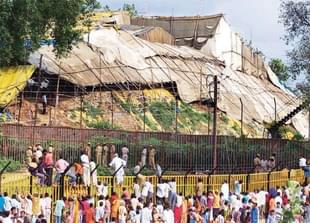Ideas
Only A Temple Can Come Up At Ram Janmabhoomi; To Suggest Anything Else Is To Digress
Vikas Saraswat
Dec 16, 2017, 10:58 AM | Updated 10:57 AM IST
Save & read from anywhere!
Bookmark stories for easy access on any device or the Swarajya app.


Those who have followed the Ram janmabhoomi-Babri Masjid dispute from the beginning will remember that the left “secular” intelligentsia, supporting the Babri Masjid Action Committee (BMAC) and opposing the case for a temple, had originally harped on the non-existence of a temple at the site as their core argument. They argued that there was no mention of the temple destruction in Babur’s memoirs and that the whole controversy was one of the many British contrivances to keep Hindus and Muslims divided – an agenda which the “communal” Vishwa Hindu Parishad (VHP) and Bharatiya Janata Party (BJP) were furthering without historical basis.
Running roughshod over collective memory of a whole nation and outright obvious marks of temple destruction in the mosque, this intelligentsia and historians were so confident of their prowess to muzzle facts that Syed Shahabuddin, one of the protagonists on the BMAC side, announced that he will himself perform kar seva if any testimony preceding the British Raj were brought in the public domain.
But when the seventeenth- and eighteenth-century testimonies of British traveller William Finch and Austrian Jesuit monk Father Tiffenthaler attesting the Hindu struggle for reclaiming the janmabhoomi were brought to notice, Shahabuddin started demanding contemporaneous evidence.
Shahabuddin’s is just one example to illustrate the shifting goalposts by the party opposed to the temple. They have questioned the existence of a temple preceding the Babri mosque, disputed Ayodhya as the birth place of Ram, argued for the case to be settled as a title dispute, called the Hindu struggle as politically motivated and belittled the temple party for their fervent religiosity “in this age and time”. While earlier all the arguments could be thrown out with nonchalance, the conclusive evidence unearthed in the court-ordered Archaeological Survey of India (ASI) findings after Babri demolition, and the pronouncement of the Allahabad High Court judgement, have considerably reduced the options for those opposing the temple.
After the verdict, their argument has reduced to indignant moral hectoring. “Who needs a temple in this age? What good will a temple serve? Will the temple remove India’s poverty? Why not construct a university at the site?” Needless to say, these are attempts to shame Hindus for persisting with their claim. A group of 30 activists led by Shyam Benegal has approached the Supreme Court demanding a monument of national unity be built on the site. There are others who have offered similar advice on various platforms.
The opponents of a temple are ready for anything, from a hospital to a toilet on the site, but not a temple. It is remarkable that they cannot think of any other piece of land for their fancies other than the birthplace of Ram. Whether these same critics would ever dare to ask similar questions to Muslims or Christians is anybody’s guess. But doubting the existence of a Ram temple at the janmabhoomi was a bad argument; the intellectual bullying now being witnessed is simply obnoxious.
That the absence of a temple and the much-celebrated secularism also couldn’t remove India’s poverty is seen by all. That the temple to Ram lalla will not be built by public funds is also known to all. That health and education remain neglected not because one such institution is missing at Ayodhya but because of general misgovernance in these areas is easy to argue. The arguments against the temple, however, are not about reason but obfuscation. The insensitivity on display is not only disturbing but reeks of intolerance. In putting forth suggestions, which mock the fealty of Ram bhakts, whether unwittingly or by design, the left brigade is only trying to push their way of life on to others.
Similarly, saying there are already many temples and one more temple will serve no purpose betrays both ignorance of and condescension towards the Hindu faith. It reveals a mindset which treats temples as no more than exotic places of visit. It tramples upon the faith of a devotee for whom both his deity and the place where it resides are sacrosanct. A Shiva devotee who might have several Shiva temples in his vicinity still longs to pray at Chidambaram, Rameswaram, Lingeswar or one of the 12 Jyotirlingas. All of these temples carry a special meaning to him.
More than anything else, the reconstruction of a Ram temple at the janmabhoomi is now about Hinduism being regarded as a living faith. It is about determining whether practising Hindus or the left liberals get to decide what Hinduism is and how, why and where Hindus get to pray. It should be noted that in the Hindu belief, murtis (idols) or vigrahas are considered living. Their representatives in this world – sevayats – have not just temporal but legal rights as well.
Courts have time and again upheld the legal rights of both deities and their sevayats. In a landmark judgement, even British High Court in 1988 upheld the Hindu deity as a juristic person. It repatriated and ordered the restitution of a Nataraja bronze, from British Museum to Pathur in Thanjavur district, where it had been stolen from. Justice Kennedy averred with the contention of lawyers Adrian Hamilton and Bhaskar Ghorpade that “once a deity, always a deity. An idol remains a juristic person however long buried or damaged, since the deity and its juristic entity survive the total destruction of its earthly form.”
One can call religious beliefs irrational, but a temple at Ayodhya alone cannot be the test case of rationalism. Ayodhya is about justice to Hindus and nothing more. That the persistent struggle has generated a communal conflict is also not of Hindu making. It is the strident and obdurate opposition to the temple, seeking to legitimise the humiliation of a nation at the hands of iconoclastic Islamic invaders, which is to blame. Neither is Ayodhya the only point of contention threatening a socio-religious schism. Christian evangelism and Muslim veto on the national song also infuriate other sections of society. Left liberals, who fear hostilities because of a temple at Ayodhya, are not only accommodating of this overt religiosity but also willing to fight for it.
After the conclusive evidence of temple remains below the Babri structure furnished by ASI, there is only one side which anyone committed to justice can support – a temple at the earliest at Ayodhya. To suggest anything else is to digress. The type of structure at Ram’s birthplace can only be the concern of his bhakts. Others, even if they are nominally Hindus, have no right to offer advice. They can either present their case against ASI findings before the courts or keep quiet. Proposing alternatives at the site is endorsing the hatred for idolatry and iconoclastic zeal of marauders who have ravaged India for hundreds of years. It is brutalising the Hindu faith like Babur and many other Islamic invaders in the past had done.





